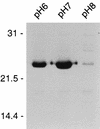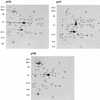Effects of environmental pH on membrane proteins in Borrelia burgdorferi
- PMID: 10377088
- PMCID: PMC116493
- DOI: 10.1128/IAI.67.7.3181-3187.1999
Effects of environmental pH on membrane proteins in Borrelia burgdorferi
Abstract
Borrelia burgdorferi, the causative agent of Lyme disease, alternates between the microenvironments of the tick vector, Ixodes scapularis, and a mammalian host. The environmental conditions the spirochete encounters during its infectious cycle are suspected to differ greatly in many aspects, including available nutrients, temperature, and pH. Here we identify alterations in the membrane protein profile, as determined by immunoblotting and two-dimensional nonequilibrium pH gradient gel electrophoresis (2D-NEPHGE), that occur in virulent B. burgdorferi B31 as the pH of the medium is altered. Initial comparisons of cultures incubated at pHs 6.0, 7.0, and 8.0 yielded alterations in the expression of seven membrane proteins as determined by probing with hyperimmune rabbit serum. Six of these membrane proteins (54, 45, 44, 43, 35, and 24 kDa) were either present in increased amounts in or solely expressed by cultures incubated at pHs 6.0 and 7.0. The 24-kDa protein that decreased in expression at pH 8.0 was identified as outer surface protein C (OspC). In addition, a 42-kDa membrane protein increased in amount in cultures incubated at pH 8.0. Similar changes were observed with serum from a mouse infected by tick bite, with the recognition of two additional bands (48 and 46 kDa) unique to pHs 6. 0 and 7.0. When membrane fractions were analyzed by 2D-NEPHGE, at least 37 changes in the membrane protein profile between cells incubated at pHs 6.0, 7.0, and 8.0 were observed by immunoblotting and silver staining. Environmental cues such as pH may prove important in the regulation of virulence determinants and factors necessary for the adaptation of B. burgdorferi to the tick or mammalian microcosm.
Figures




References
-
- Ahlqvist J. A hypothesis on the pathogenesis of rheumatoid and other non-specific synovitides. IV A. The possible intermediate role of local hypoxia and metabolic alterations. Med Hypotheses. 1984;13:257–302. - PubMed
-
- Balashov Y S. Bloodsucking ticks (Ixodoidea)—vectors of diseases of man and animals. Misc Publ Entomol Soc Am. 1972;8:161–376.
-
- Benach J L, Coleman J L, Skinner R A, Bosler E M. Adult Ixodes dammini on rabbits: a hypothesis for the development and transmission of Borrelia burgdorferi. J Infect Dis. 1987;155:1300–1306. - PubMed
-
- Berger B. Erythema chronicum migrans of Lyme disease. Arch Dermatol. 1984;120:1017–1021. - PubMed
MeSH terms
Substances
LinkOut - more resources
Full Text Sources

